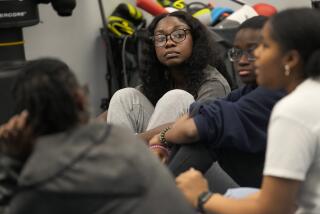Teach Students to Think, Write as They Aim for Future
- Share via
Each September, I tell my senior English students that I need to know what they want to learn. What do they think they really need to know? I promise to teach them only those things.
They do not believe me. In fact, they are uneasy. After all, they are seniors in a college prep course with college applications looming on the horizon.
Well and fine, I tell them. Not to worry. What do you think you must comprehend in order to lead full lives? And lives that are happening now, not in some faraway future.
This year, the Class of 2001 asked the following questions: Will anyone love me? Will I have the courage I need to face failure? How will I know right from wrong? Will I make a difference in the world? What happens after death? What is success?
Using “Hamlet,” “Twelfth Night,” “Oedipus,” “Gilgamesh,” the teachings of Confucius and Lao Tze, Asian poetry, Dante, “Anna Karenina,” we probed many of their excellent queries. Cumulatively, the anguish of souls in classical and modern literature struggling to find themselves with meaning and integrity spilled over into my students’ lives. Almost unconsciously, they began to synthesize experiences, finding them analogous to their own in a qualified way. In my mind, they are ready to go to college so the conversations can continue.
But the question of how to measure their readiness arises. The SAT, challenged recently by UC President Richard C. Atkinson as a viable indicator of student readiness for college, remains the elusive Grail that millions of high school seniors equate with academic readiness.
The test, intentionally boring and frustrating with obscure and debatable responses available, measures little and should be discarded. I’ve had to waste time on lists of arcane words for possible vocabulary testing on the SAT, cramming them into minds willing to grab them long enough for a quiz or the test, but not long enough to actually use them.
The SAT II, a recent and more relevant addition to the testing family, requires performance along with close textual analysis. Good. Students should produce on-the-spot writing unassisted by tutors or parents or Internet. Relying on this part of the SAT, along with a thorough perusal of background and application with school grades, may suffice as entry criteria. Let students tell universities what they know, how they think, how they assemble arguments, what ideas are truly cogent to them.
Read their college application essays very carefully, for while some may be produced dishonestly, most are not and they are touching, funny, revealing pages of thinking.
If not the SAT, what should take its place? The comprehensive look at student performance is admirable but expensive. It means that people have to sit around a table together and read essays, counterbalance grades, look at needs and somehow make a call. Perhaps a core group of secondary teachers could participate and sit at this table.
A few years ago, I helped assess the Subject A English Placement exam for the UC system, working with UC English professors from every campus.
For days, the professors and I toiled, seeking students with voice, exciting diction, writers with a true point of view willing to take some risks with ideas and structure. We rewarded those writers by placing them in advanced composition classes in the UC system.
Those sessions deepened my own teaching commitment and confirmed my efforts in the high school classroom. I knew that I was teaching students to think and write to meet the demands of their final academic adventure.
In revisiting assessment tools for college placement, I would encourage continued use of the SAT II, closer scrutiny of the application essay and formalized collegial efforts involving secondary teachers to enrich each student, each institution.






